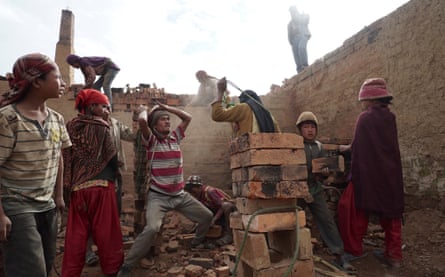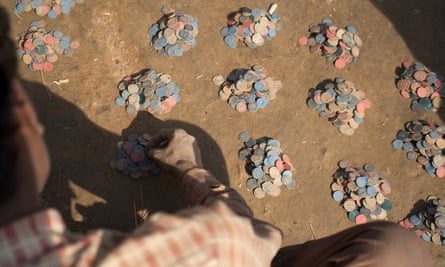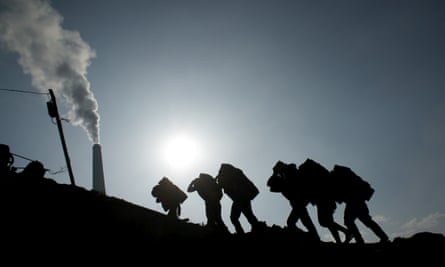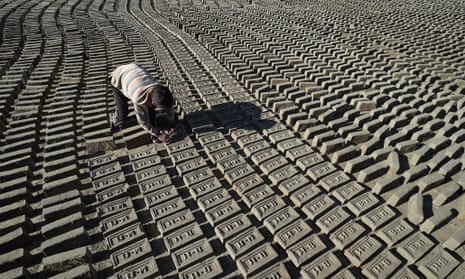Children as young as eight are working 15-hour days making bricks that have been used in major international development projects in Nepal, including a World Food Programme (WFP) project funded with $3.2m (£2m) of UK aid money.
A Guardian investigation has revealed that “blood bricks”, tainted by human rights abuses such as child labour, have also been used in other major construction projects in Nepal, including a multimillion pound upgrade of Tribhuvan international airport funded by the Asian Development Bank (ADB), a new Marriott hotel and a project to improve Kathmandu’s domestic air terminal.
The findings suggest that international donors, aid agencies, multinational companies and the Nepalese government are systematically failing to ensure that there are effective policies in place to keep their supply chains free from child and bonded labour, and have failed to recognise the appalling conditions prevalent in Nepal’s brick industry.
The brick industry in Nepal is booming, with more than 1,100 kilns operating across the country. The industry is characterised by long hours, low pay and a system of debt bondage. Experts estimate that up to 28,000 children are working in brick kilns across Nepal, of whom half are under 14, with tens of thousands of adult labourers potentially trapped in conditions amounting to forced or bonded labour.
At the Bhramhayani Mata brick factory near Bhaktapur, a town adjoining Kathmandu, hundreds of workers from some of the poorest regions in Nepal sleep in tiny shacks spread out across the fields where they work. At 1.45am, eight-year-old Shankar Thing and his three teenage brothers are among the workers heading out into the freezing darkness to start their day’s work.
Sixteen-year-old Bishal Thing rigs up a single lightbulb, turns on a radio and, to the beat of Nepali pop music, they begin the gruelling task of making bricks for the next 15 hours.
All around them, other families are doing the same, until the whole valley echoes with the sound of blaring radios and the relentless thud of moulds hitting the ground as they turn out yet another brick.
“Sometimes my younger brothers cry [because it’s so cold],” Bishal says as he gouges out a handful of mud from the pile beside him. “It feels like something is cutting your hand. It’s not right [that my brothers are doing this]. It’s wrong, but we are poor, so we need to work. We can’t eat if we don’t work.”
Prem Thing, 14, is wearing shorts and a pair of flip-flops over his socks. “I wanted to stay at home, but the broker brought me here,” he says.
The majority of bricks from the Bhramhayani Mata factory will end up in domestic construction. However, the Guardian has established that bricks from the factory, or one of its two partner factories, have also been used on a major WFP development project, with the help of funding from Britain’s Department for International Development (DfID). The construction, a staging area for emergency supplies and support in the event of a major natural disaster, is one of three that the WFP plans to build in the next few months. The Guardian visited all three partner factories in the past month and verified that similar working conditions exist at all.

The WFP says it demands that all of its contractors and their suppliers adhere to the UN convention on the rights of the child.
A spokesperson said: “As part of routine project monitoring, we became aware that certain minor building works at the Tribhuvan airport were being undertaken by a contractor using bricks that did not meet WFP’s high environmental and ethical production standards.
“As a result, in early January WFP ordered the contractor to halt the purchase and use of these bricks for all subsequent construction, and to use only cement bricks/breeze blocks or prefabricated elements sourced from suppliers who are able to meet UN standards.”
A DfID spokeswoman said: “WFP are no longer using the supplier in question. The integrity of supply chains is hugely important. We expect all the partners we work with to carry out rigorous due diligence and ongoing project monitoring and supplier checks.”
Just 2km away from the four brothers, Mahila Lama, a 46-year-old brick labourer from Kavre, is also starting his day, at the Bhramhayani Mahabir brick factory. For the past 11 years he has worked every brickmaking season here, paying off loans he has taken the previous year to get him through the monsoon months when the brick kilns shut down.

“I can go home for a few days, but I can’t leave the work,” Lama says, as he cooks vegetables on a stove inside the tiny hut where he lives alongside the bricks he makes. According to Lama, if he leaves, the middleman who recruited him will force him to pay 24% interest on the loan, and the owner of the factory will demand he pays rent on the land where he makes the bricks. Lama can afford neither. “For the son of a poor man, this is how it is,” he says.
Mahila Lama’s plight is unlikely to be on the minds of many of the 600,000 tourists who fly into Kathmandu’s international airport each year, but in the future they will all benefit from his punishing labour. About 50,000 bricks from the factory where Lama works have been used in a major project to upgrade the international airport. Constructora Sanjose, a Spanish firm, is overseeing the development of the project, which is largely funded by the ADB and set to cost £60m.
Kenichi Yokoyama, Nepal country director for the ADB, said: “ADB requires the government of Nepal and its executing agency, Civil Aviation Authority of Nepal (Caan), to ensure that contractors comply with applicable core labour standards and labour laws, do not employ child labour, and eliminate forced or compulsory labour. We are urgently investigating this matter.”
Constructora Sanjose has also pledged to investigate its supply chain.
Having passed through the airport, tourists may well end up booking a room at the Fairfield by Marriott hotel, which opens in Kathmandu this year and will boast luxurious rooms. A small number of bricks used in the hotel’s basement were made at the Om Himalayan kiln, where the Tamang family work.
Their accommodation is a temporary brick shelter with a corrugated iron roof, held down by sticks. As the sun rises over the kiln, the family’s 12-year-old daughter has already been at work for five hours, pounding out brick after brick with her parents. “Last season, we only earned 10 or 15,000 rupees (£66–99), so we had no option but to take an advance,” says the husband, who borrowed 75,000 rupees at the end of the previous season.
Even if they were able to settle their debt early, they are still not free to leave. “We can’t leave unless we get sick … if we are fit to work we have to stay here,” the husband says. “The broker and owner don’t allow us to leave because they have leased the land and if we leave it is their loss.”
The Tamangs hope they will get paid 800 rupees for every 1,000 bricks they make, but they do not know for sure because they will not get paid until the end of the season. “There are no contracts here,” the husband says. “We don’t ask questions about it because it’s like this everywhere.”
A spokeswoman confirmed that the Fairfield by Marriott is due to open in 2017 and will be managed by Marriott Hotels International Limited, but said responsibility for the construction process lay elsewhere. “The owner and developer of the hotel is Nepal Hospitality Group Private Limited and, as they are overseeing the construction, any questions pertaining to this matter are best answered by them,” she said.
Nepal Hospitality Group Private Limited, which is using APM, a local construction company, to carry out the works, did not respond to requests for comment.

The trail of blood bricks also leads to Kathmandu’s domestic terminal, the gateway to the country’s famous trekking routes. An annexe to the domestic airport is under construction, which will significantly improve the dilapidated terminal. The development has been commissioned and funded by the Civil Aviation Authority of Nepal, at an estimated cost of 109m rupees.
Underneath the tiles being fixed to the walls of the new building are bricks from the Jaya Shankar factory in the nearby town of Bhaktapur, where some workers are trapped in conditions of forced labour.

Shiva Kumar Sada, 25, was brought to the factory along with 14 other workers in mid-November from their village in Saptari district, in the south.
Their broker promised each of them 800 rupees a day, which would be paid weekly, and in return they each took a small advance of 2,000-3,000 rupees. But over three weeks after arriving they had still not received anything. Five of the group have already given up and returned home without payment.
“They told us we would get 800 rupees a day, but now they have promised us 700. I haven’t been paid anything besides the advance. We’re buying food with credit,” Sada says. “Sometimes we feel like we have been cheated … we trust the broker because we need the money.”
Homraj Acharya, Nepal’s country director for the Global Fairness Initiative, who is managing the Brick Clean Group – a project to incentivise brick factory owners to improve working conditions – says international donors, banks and aid agencies must share responsibility with the government for working conditions at brick kilns.
“It is imperative that the international community create procurement policies that ensure any bricks they purchase are free of child and bonded labour,” Archarya says. “Our money should follow our morals.”
But for children like Bishal, the chance to benefit from such an initiative may have already passed. “I don’t know what will happen [to me],” he says. “I’m already broken.”

How does bonded labour work?
- The brick kiln owner gives money to a middleman.
- The middleman distributes the money to families as an advance to secure their labour for the next brickmaking season and help in the monsoon months when the kilns are closed.
- Families relocate to the kiln at the start of the season. Workers get a guaranteed job but are not paid in full until the end of the season. If they leave before then, they risk losing their earnings.
- If they try to leave before the season is over, some workers risk being charged high interest rates on the advance or rent on the land where they work.
- It can be very difficult for workers to pay back the advance before the end of the season because they cannot earn enough to do so, forcing them to take another advance for the following season.

Comments (…)
Sign in or create your Guardian account to join the discussion